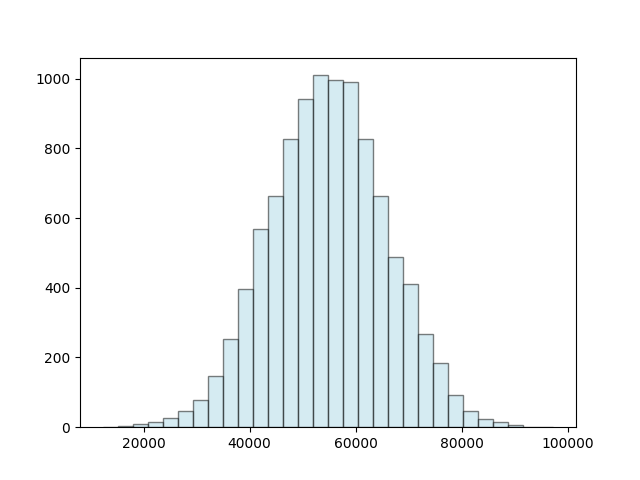Valuing Uniswap V3 Liquidity Positions#
This guide walks through the process of querying a Uniswap V3 pool from an on-chain state
Setting up Simulation#
import logging
import numpy as np
from tqdm import tqdm
from matplotlib import pyplot as plt
from web3 import Web3
from eth_utils import to_checksum_address
from nethermind.entro.base import PoolFactory
from nethermind.entro.uniswap_v3 import UniswapV3Pool
LIQUIDITY_SNAPSHOT_BLOCK = 14000000
LP_POSITION_MANAGER = to_checksum_address("0xC36442b4a4522E871399CD717aBDD847Ab11FE88")
pool_factory = PoolFactory(
sqlalchemy_uri=f"postgresql://user:pass@host/db_name"
w3=Web3(Web3.HTTPProvider("https://localhost:8545", request_kwargs={"timeout": 60})),
logger = logging.get_logger("position_simulations")
)
Querying Historical Pool States#
Caching Pool States
Through the load_pool() and save_pool() methods, the on-chain query results can be cached. This reduces the setup time for a pool from 10-40 minutes to a few seconds.
def initialize_pool(pool_factory, pool_address, at_block) -> UniswapV3Pool:
if os.path.isfile(f"pool_states/{pool_address}_{at_block}_pool_state.json"):
with open(f"pool_states/{pool_address}_{at_block}_pool_state.json", "r") as f:
return UniswapV3Pool.load_pool(f, pool_factory)
else:
pool = pool_factory.initialize_from_chain(
pool_type="uniswap_v3",
pool_address=to_checksum_address(pool_address),
at_block=at_block,
)
with open(f"pool_states/{pool_address}_{at_block}_pool_state.json", "w") as f:
pool.save_pool(f)
return pool
>>> usdc_weth_pool = initialize_pool(pool_factory, "0x88e6A0c2dDD26FEEb64F039a2c41296FcB3f5640", LIQUIDITY_SNAPSHOT_BLOCK)
# Verify that pool is initialized correctly
>>> usdc_weth_pool.immutables.fee
500
Simulating Pool Activity#
Now that we have a pool state initialized, we can simulate ppool swaps and analyze their impact on individual positions, and the greater pool state.
Simulating Synthetic Swap Dataset#
>>> TRADE_COUNT = 10_000 # Number of Swaps to Simulate
>>> MAX_TRADE_SIZING = 100_000 # Max Trade Size in USD
>>> MIN_TRADE_SIZING = 10_000 # Min Trade Size in USD
>>> normal_distribution = np.random.normal(0, 0.2, TRADE_COUNT)
>>> trade_range = (MAX_TRADE_SIZING + MIN_TRADE_SIZING) / 2
>>> trade_amounts = []
>>> for datapoint in normal_distribution:
... trade_amounts.append(trade_range + (datapoint * trade_range))
# Plot the trade sizing
>>> plt.hist(trade_amounts, bins=30, alpha=0.5, color="lightblue", edgecolor="black")
>>> plt.show()

The next step is to convert these USD trade sizes into raw token_0 and token_1 amounts, and execute the swaps on the pool
>>> for index, trade_amount in enumerate(tqdm(trade_amounts)):
... swap_direction = np.random.choice([0, 1])
... sqrt_price_limit = TickMathModule.MIN_SQRT_RATIO + 1 if swap_direction else TickMathModule.MAX_SQRT_RATIO - 1
... amount_specified = int(trade_amount * (10 ** 6) * (1 if swap_direction else -1))
... pool.swap(amount_specified=trade_data, swap_direction, sqrt_price_limit)
... pool.advance_block(4)
...
... # Every 50 swaps, log position valuations to the database
... if index % 50 == 0:
... pool.save_position_snapshot()
Getting Historical Pool Swaps#
Note
This Process is in the process of being automated with improved UX. This is currently possible by scraping swap events starting at the pool_initialization block, and going forward a few months.
Visualizing Position Valuations#
Note
USD Position Valuation is in the process of being implemented.
>>> active_position = usdc_weth_pool.get_position_valuation(LP_POSITION_MANAGER, 194890, 195510)
>>> active_position
block_number token_0_value ... token_1_value_usd position_value_usd
0 12384693 3.953397e+06 ... None None
1 12384653 4.339269e+06 ... None None
2 12384613 4.800521e+06 ... None None
3 12384573 4.742173e+06 ... None None
4 12384533 4.874176e+06 ... None None
.. ... ... ... ... ...
195 12376893 6.523035e+06 ... None None
196 12376853 6.374573e+06 ... None None
197 12376813 6.320359e+06 ... None None
198 12376773 6.687767e+06 ... None None
199 12376733 6.326365e+06 ... None None
[200 rows x 6 columns]
>>> fig, ax = plt.subplots(figsize=(20,10))
>>> pos_1.plot.line(x="block_number", y="token_0_value", ax=ax)
>>> pos_1.plot.line(x="block_number", y="token_1_value", secondary_y=True, ax=ax)
>>> plt.show()
